Slack is a communication app that we will use to answer questions and share important information prior to and during the GMS 2023 conference. We will also be using this app to replace the hallway conversations and other social aspects of a conference that we can’t easily reproduce on Zoom; in fact, we will be offering an award for the Slack participant who best helps tie this aspect of the conference together.
You can access Slack through your web browser or download an app for your computer, smartphone, or tablet. There are advantages to each of these approaches. For the best balance of staying in touch with the conference while giving yourself room to step away when you need a break, we recommend visiting this link to download the Slack app onto the computer that you’ll be using to participate in the conference. If you really want to be involved, it’s helpful to also download Slack onto your smartphone; however, if you do this, make sure that you have your notifications set the way you want to (we’ll cover this later in the walkthrough).
Leading up to the conference, we will be starting conversations and sharing information through the app; we recommend checking in every once in a while to participate and to stay informed. During the conference, Slack will be especially important for chatting with other participants, discussing sessions, and networking with others, so remember to open the app and see what’s going on!
Perhaps the best way to get acquainted with Slack is to dive right in, test things out, and start chatting with people. There are plenty of cues for how to get started, and if you get lost, you can always ask someone else in the app for help. However, we’ve also set up the following walkthrough to give you a few tips for getting started with Slack. We recommend that you take care of these steps soon after you register; that way, you can be involved in pre-conference conversations and also be ready for interactions once things get started on June 1st!
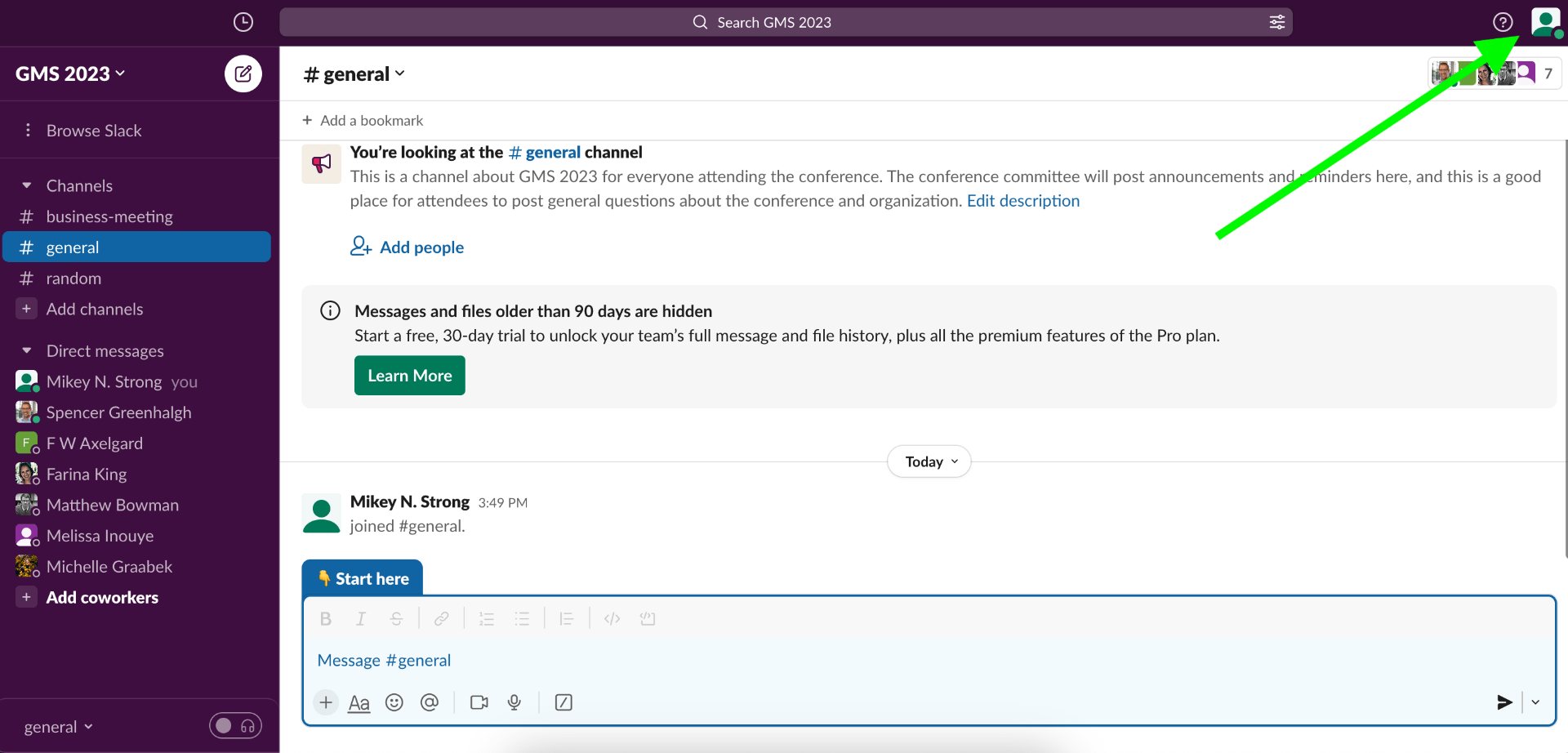
When you first join our Slack workspace, you’ll see something like the screen above. We’re using the dummy account Mikey N. Strong as an example here. Your joining the app will trigger a notification in the #general channel so that people know that you’re here and can welcome you. We’ll talk more about channels in a bit, but suffice it to say that Slack sets up different spaces for different kinds of conversations; this helps people talk about whatever they want but in different spaces, so that things aren’t overwhelming.
You may see some conversations that have already started and should feel free to join in. However, before getting too involved, we recommend clicking on the button in the top-right corner (see the green arrow) to customize your account.
Clicking on that account will open up a menu with a few different options. For example, you can check out the Preferences to customize how the app works for you. However, the most important thing for our purposes here is to click on the Profile option on the menu (see the green arrow).
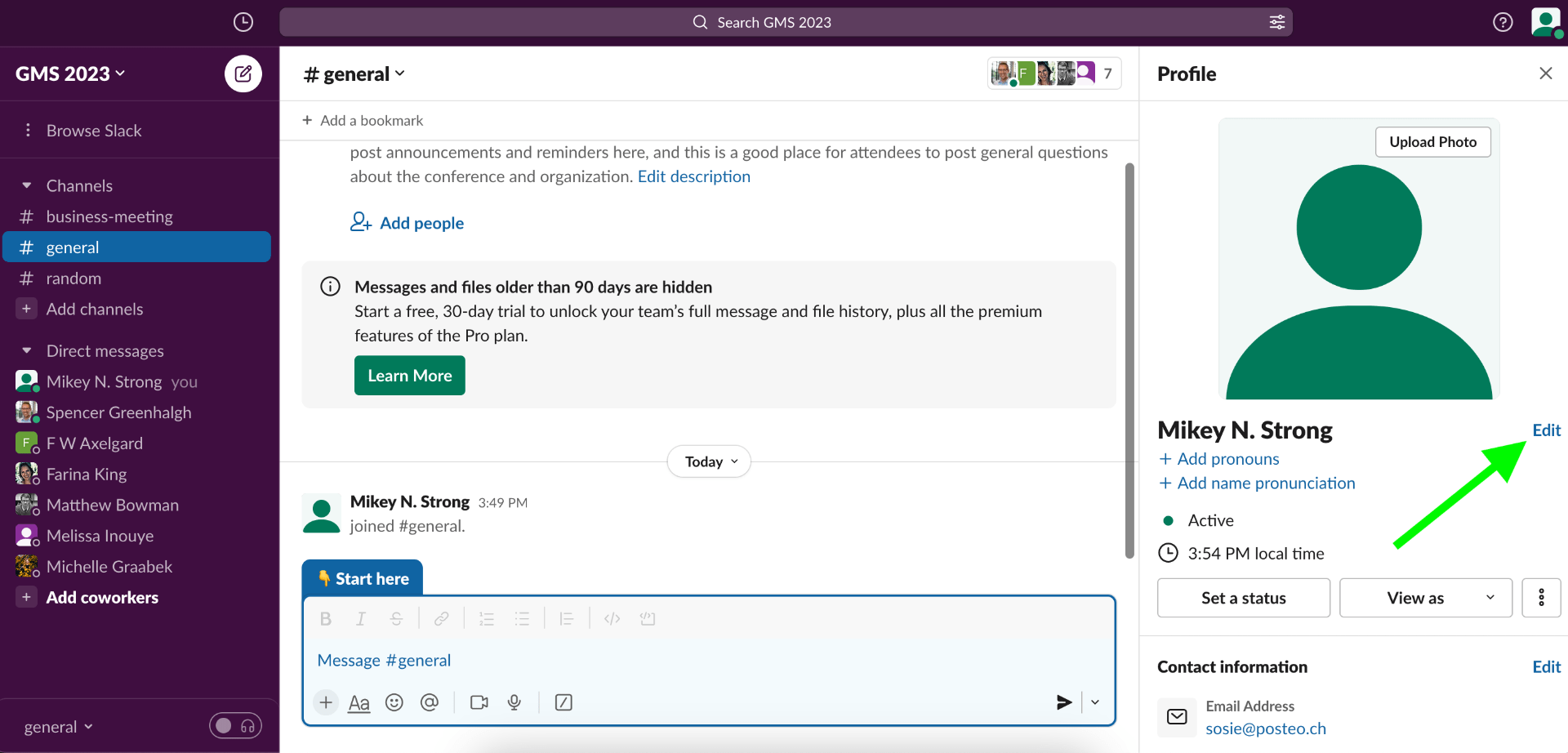
Clicking on the Profile button will bring up this sidebar. You can use the sidebar to add some basic information. Depending on where else you’ve registered the email address you used to join this workspace, it’s possible that Slack will automatically pick a profile picture for you; otherwise, we recommend adding one on your own (helpful for getting to know you!). Please also consider adding pronouns and name pronunciation (so that we address you the way you’d like to be addressed!). Once you’ve done that, you can click on the Edit button (see the green arrow) to provide some more details.
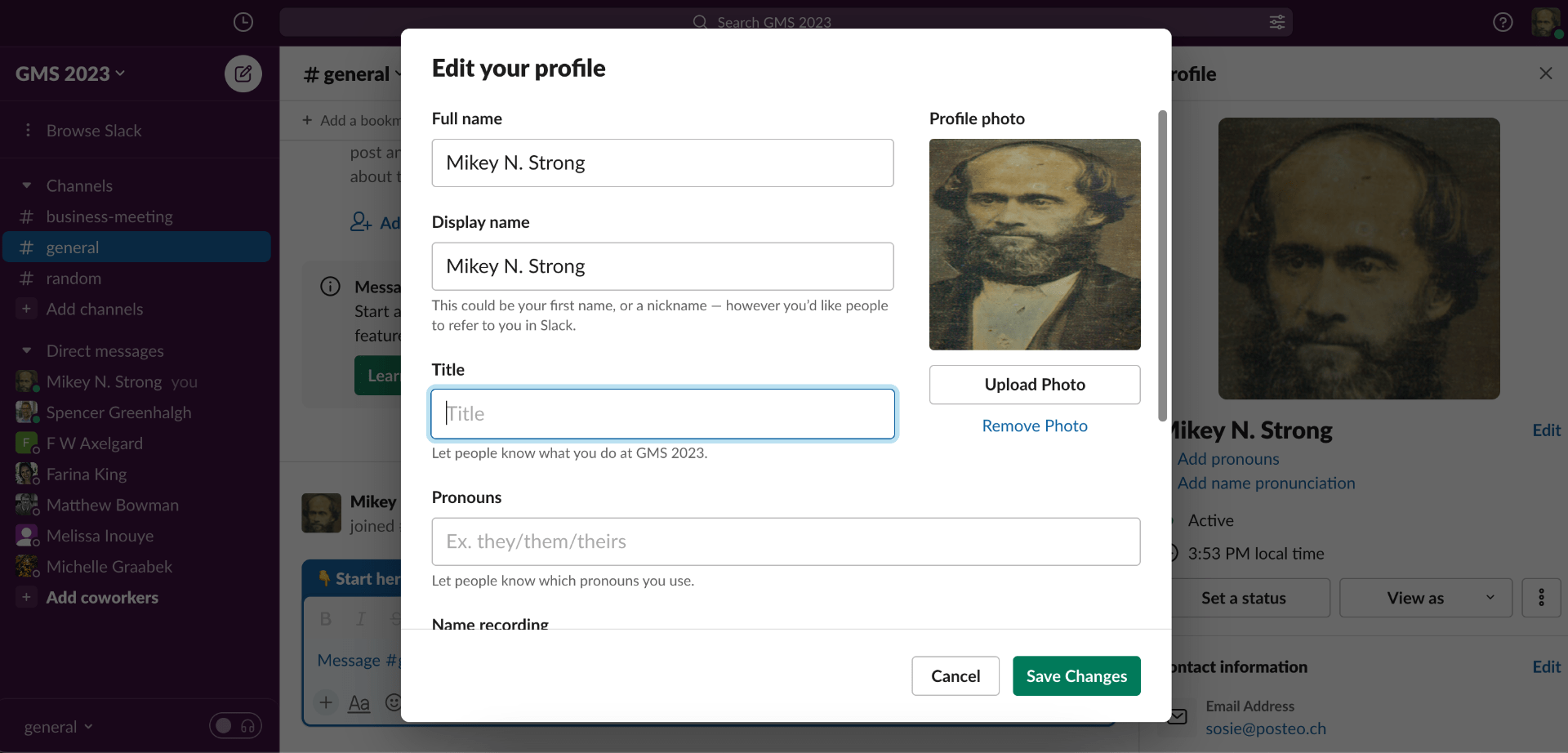
This screenshot shows what we see after clicking the Edit button from earlier. We see that Mikey now has a profile picture uploaded; we can also see that there are some additional options for what kind of information you can include about yourself. We recommend using the Title field to display an institutional affiliation or similar information. If you click on someone’s username in Slack, it will bring up all of this information so that other folks can get to know you; having your profile filled out can help you network better with others, and you might also consider exploring other people’s profiles to see what this is like!
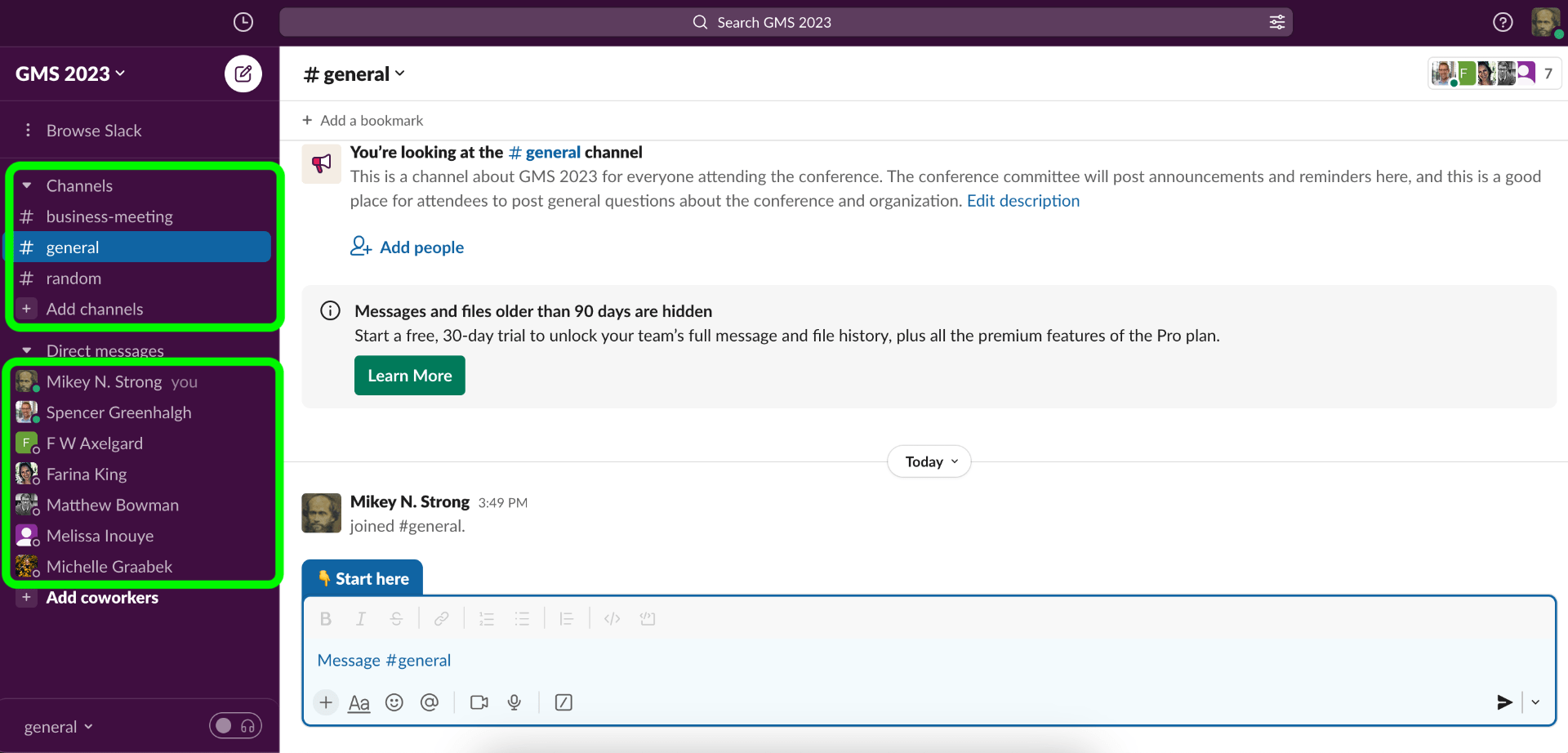
Now that Mikey’s profile is filled out, let’s take another look at what he sees when he opens up Slack. As we hinted at earlier, Slack is meant to facilitate conversation—but it also understands that not everyone wants to be involved in every conversation. So, these conversations are separated from each other within the app.
If you want to have a one-on-one conversation with someone without involving others, you can also click on their name in the list of members of the Slack workspace (see the lower green box). This is a great way to have conversations about future collaborations, exciting work, or anything else.
However, a lot of conversations are meant to happen with others around. The main way that public conversations are separated are by channels. For example, when anyone joins our GMS 2023 Slack workspace, they are automatically added to three channels (see the upper green box):
- #general, where general conversations (go figure!) about the conference take place; this is a good place for any conversation that you think is relevant to everyone or that doesn’t fit in any of the other channels
- #random, where off-topic (but still respectful!) conversations can take place; if you want to ask GMS folks about what sports they’re following, what books they’re reading, or what movies they’re watching, this is a great place to do it
- #business-meeting, where conversations related to an asynchronous business meeting of the GMS network will take place throughout the conference
However, these aren’t the only channels that are out there! We’ve created a lot of different channels related to specific events and specific interests within GMS. If you click on the Add channels button at the bottom of the channel list, you can start to bring them all up.
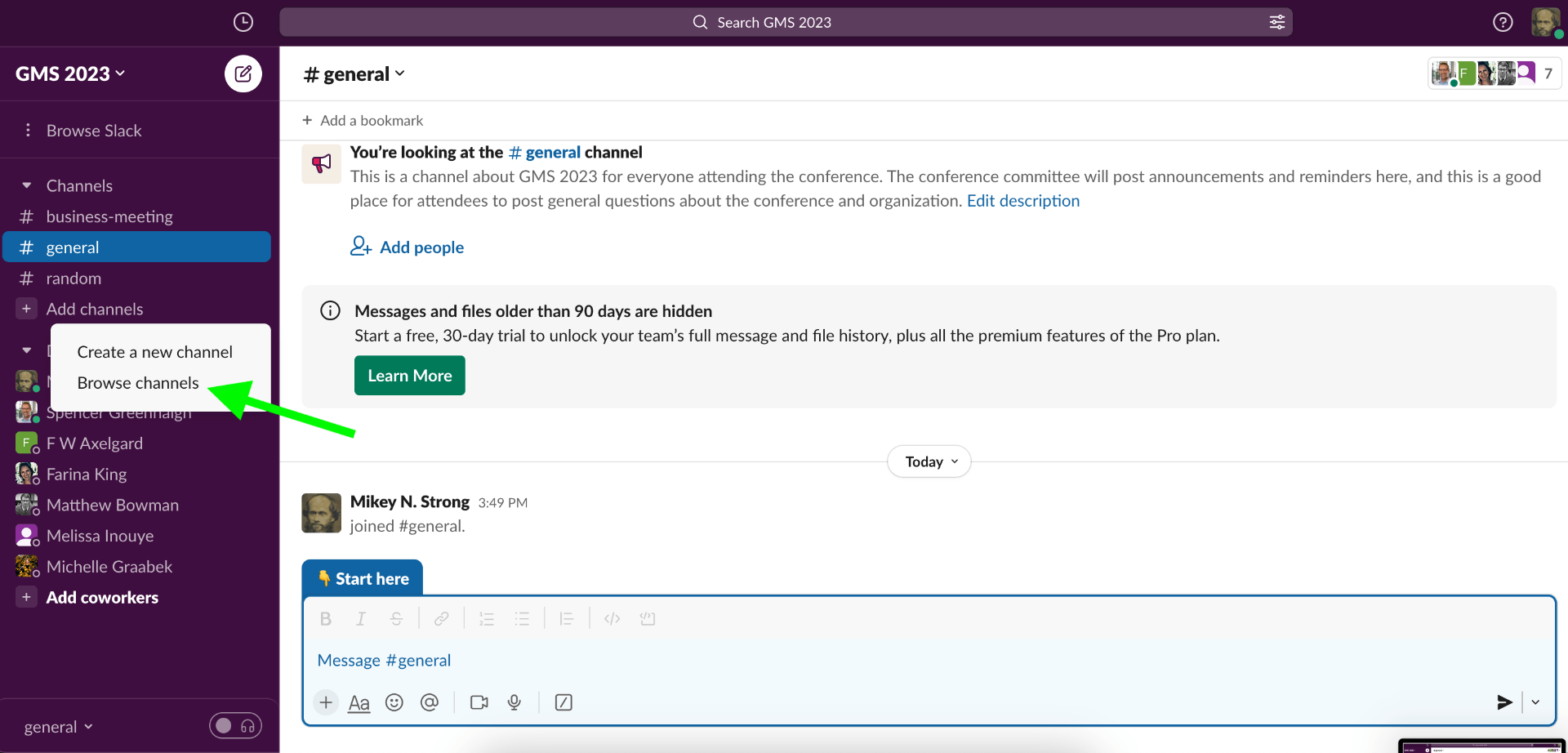
Once you click on that button, you’ll see a couple of other options brought up. You can click on Create a new channel if you want to create a private chat space for a small group of people. We’ve disabled your ability to create new public channels that anyone can join, but we also know that we might have missed some valuable public channels. Please reach out to Spencer Greenhalgh in Slack if you have a request for a new public channel, and we’ll consider putting it up!
More interesting here is the Browse channels button; this will give you a list of all of the available public channels.
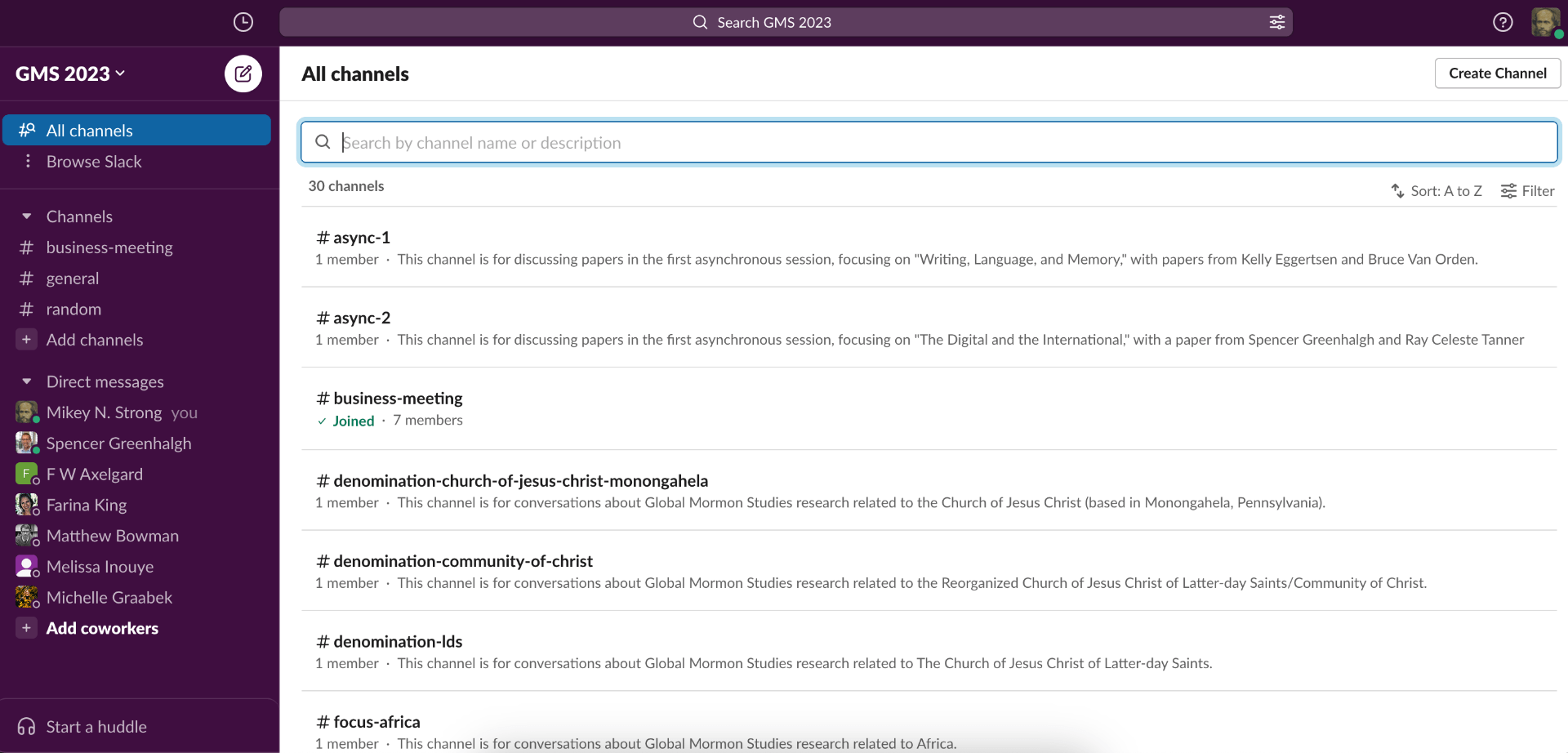
As you can see, there are several channels that are already created in Slack. Some of these channels (like #async-1 or #async-2) are connected to specific conference events. If you want to talk about a session that you’re really interested in—whether before, during, or after the session—you should join the session that’s associated with it. We encourage presenters to be active in those sessions to soak up your praise and answer your questions. Other channels (like #denomination-lds or #focus-africa) are for specific research interests.
These channels will give you a chance to network with people doing similar GMS work to you—and make it so that you don’t have to filter out conversations that aren’t relevant to your work. There’s a list of them already set up, so we recommend going through them to find the ones that you want to join. You can join channels from this page, but you can also click on the name of a channel to explore it a bit more before committing.
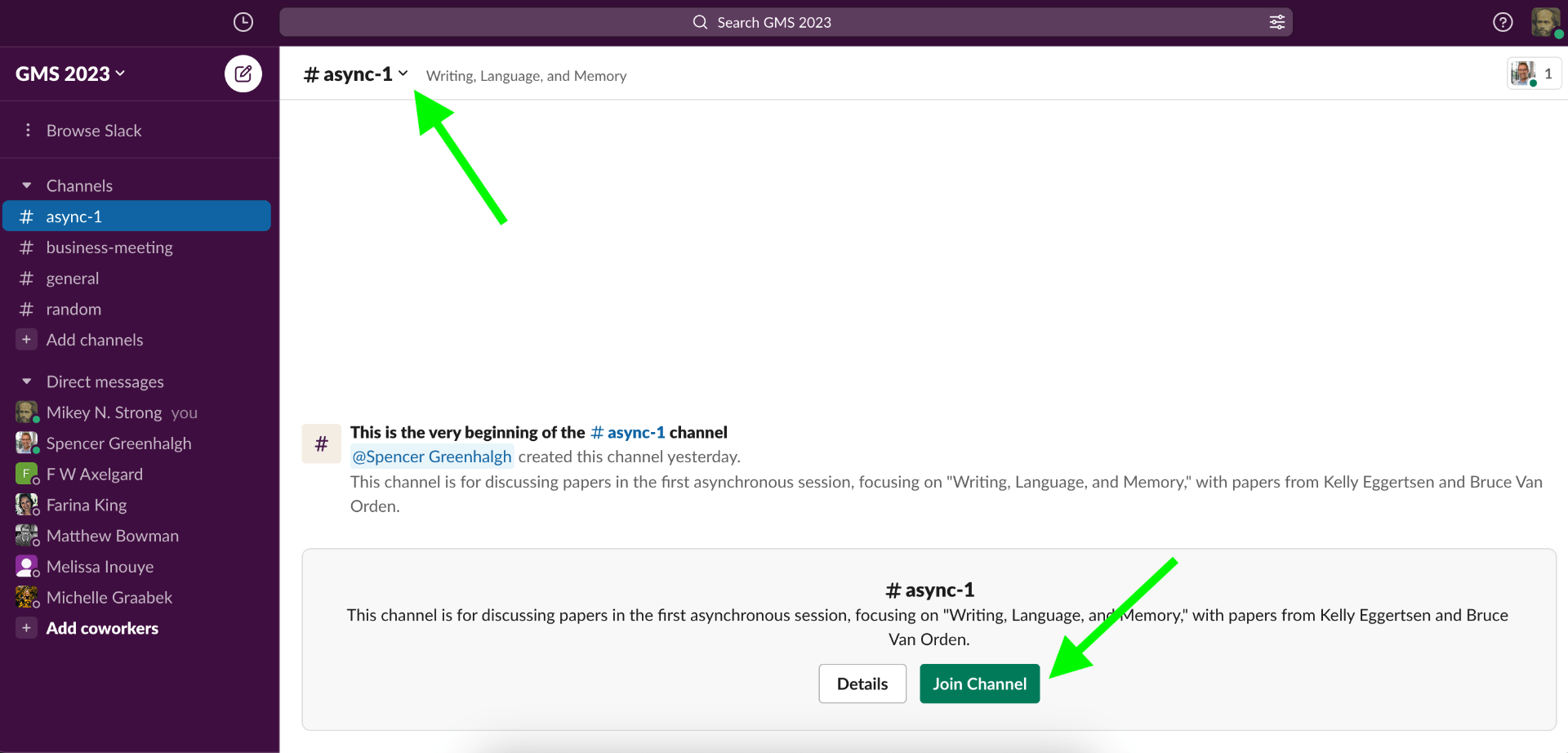
Once you’re in a channel to explore it, you’ll see a button at the bottom (lower green arrow) allowing you to join that channel. After you have joined the channel, you may also want to bring up the menu for that channel (upper green arrow) so that you can fiddle with some of the options here.
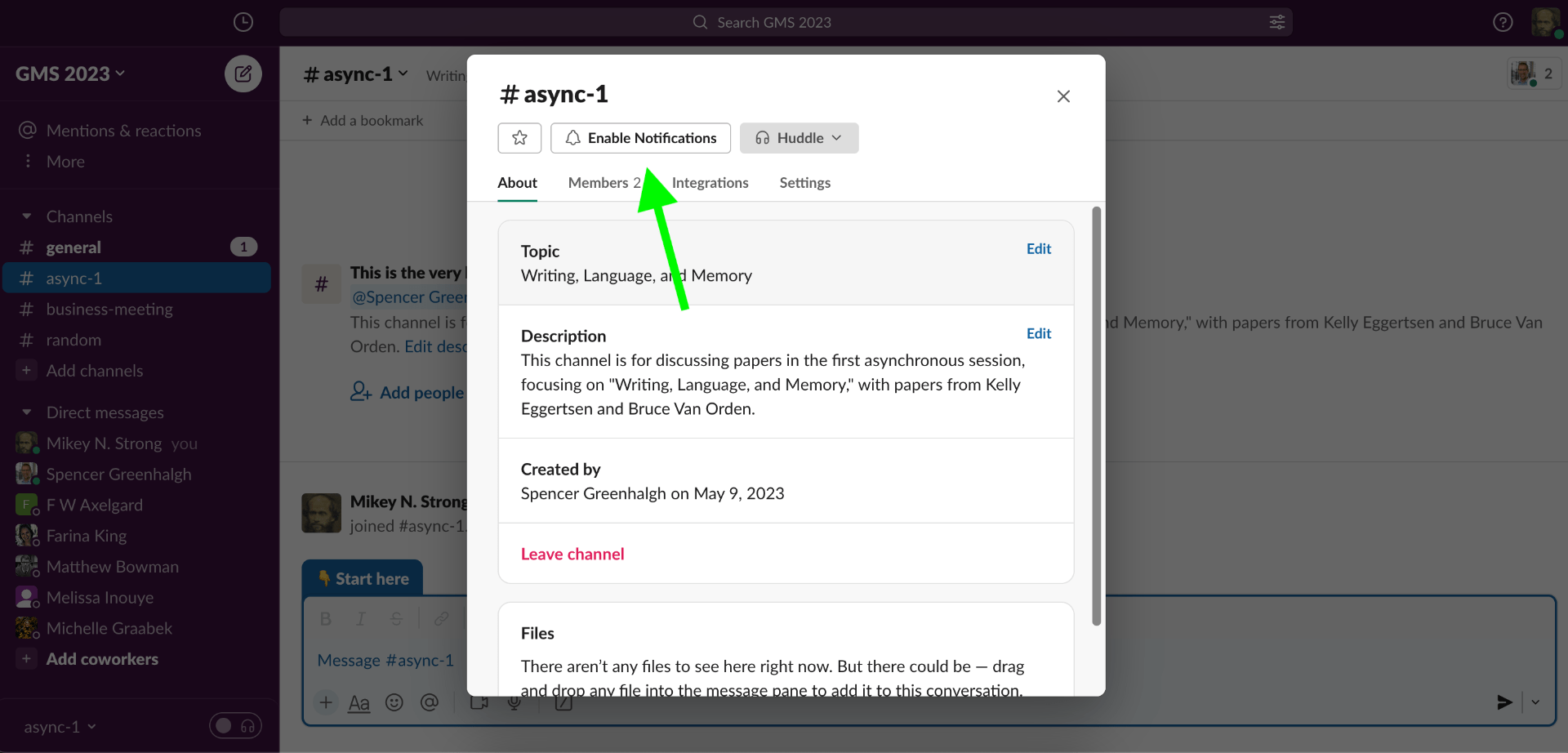
The most important thing to do on this menu is to fiddle with the notification options. We hope that there will be a lot of rich conversations in Slack before, during, and maybe even after the conference! However, Slack recognizes that a lot of conversations can mean a lot of notifications, and we don’t want to overwhelm you, especially if you’re participating from your phone. Depending on how interested you are in a channel, you may want to change what kinds of notifications you get. For example, a presenter may want to get notified about all messages in the channel associated with their session; however, someone who’s only casually interested in the session may want something more low-key.
First, though, depending on how you’re accessing Slack, you may have to Enable Notifications for Slack on your device (see green arrow). If you don’t see this, it means that notifications are already enabled for you.
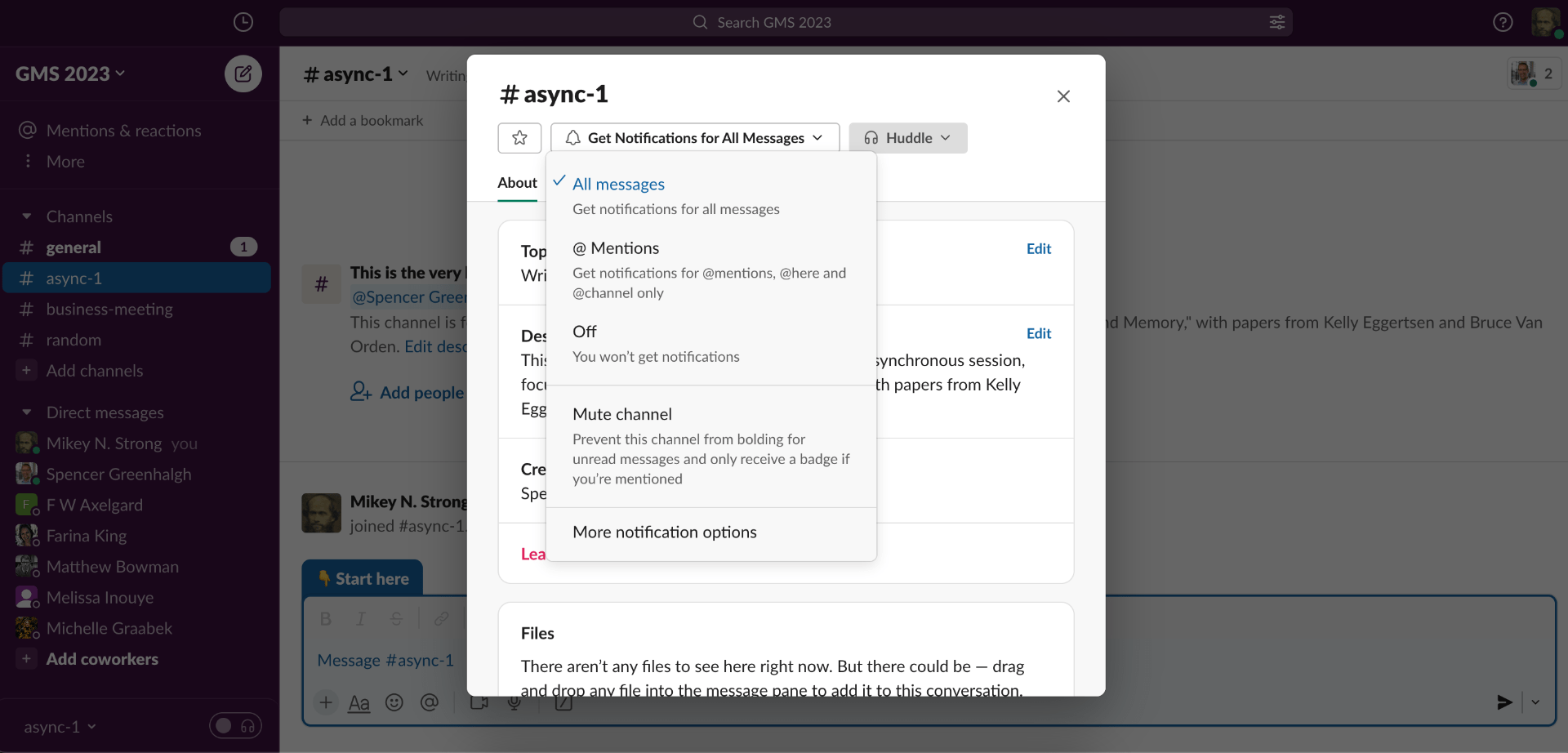
Once your notifications are enabled, you can figure out what kinds of notifications you want to see from a particular channel. You can get a notification for all messages in the channel, a notification only when someone mentions you by username, or no notifications whatsoever.
“No notifications” might seem unintuitive, but all this means is that there won’t be any sounds or pop-ups on your phone or computer when there are new messages. Slack has other ways of demonstrating that there’s been activity in a channel. For example, even though it’s kind of dim, check out the sidebar in the image above. You’ll see that the #general channel appears in bold font (unlike the others) and that there’s a number to the side of it. That means that there’s new activity in that channel that you might want to check out. If you see a channel whose name appears in bold, that means that there have been new posts there since the last time you checked it. This internal notification works separately from the notification on your phone or computer; in other words, you can choose to get no sounds or pop-ups but still see what’s going on once you open Slack on your own.
For our next step, let’s see what that new activity is in the #general channel. If you click on the name of the channel, you’ll be transported right there.
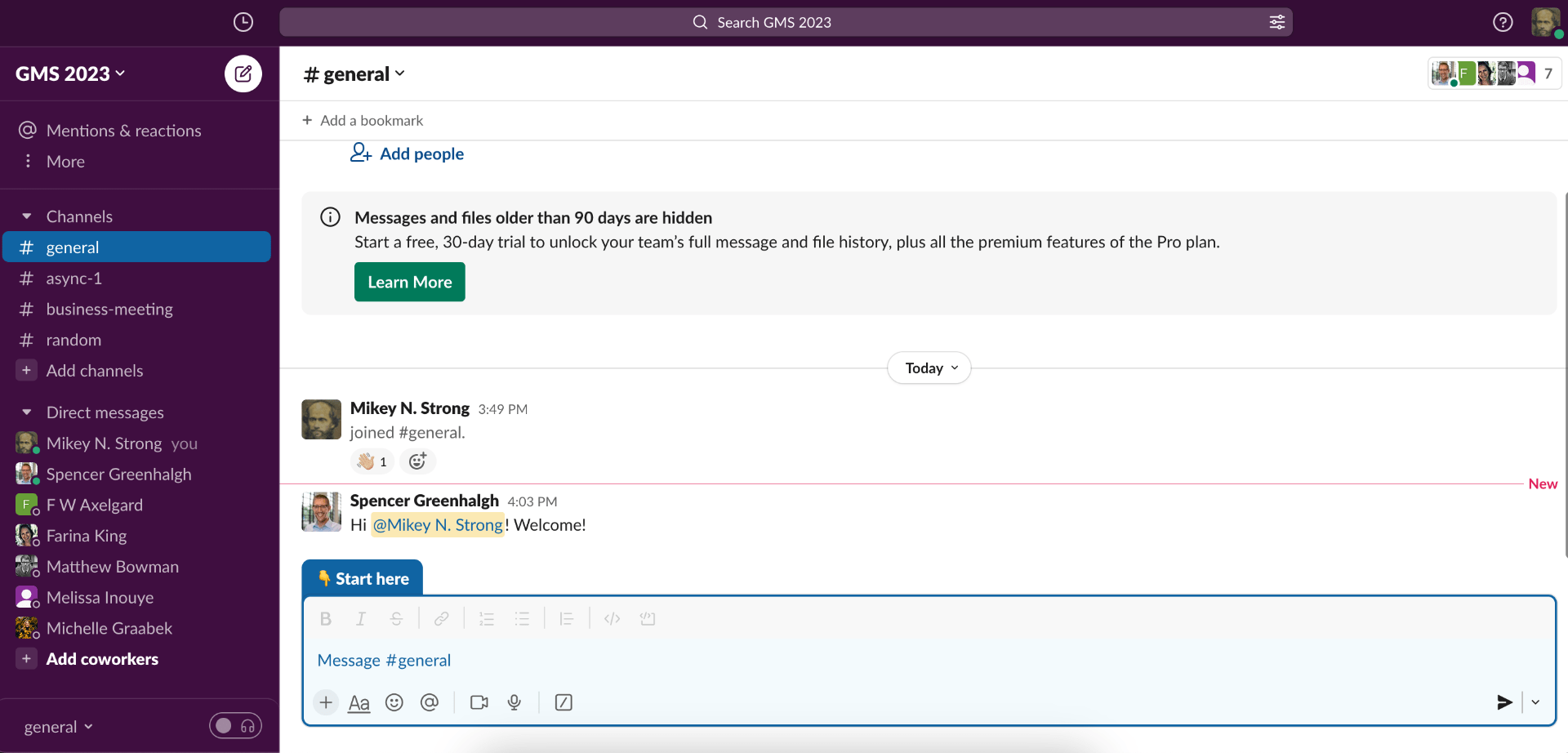
Now that we’re there, Mikey can see that Spencer responded with a 👋🏼 emoji to the announcement that he’d joined the channel. He also wrote Mikey a welcome message, specifically mentioning him (using an @ character, starting to write his username, and selecting him from the menu that came up) to make sure it’s clear he was talking to Mikey.
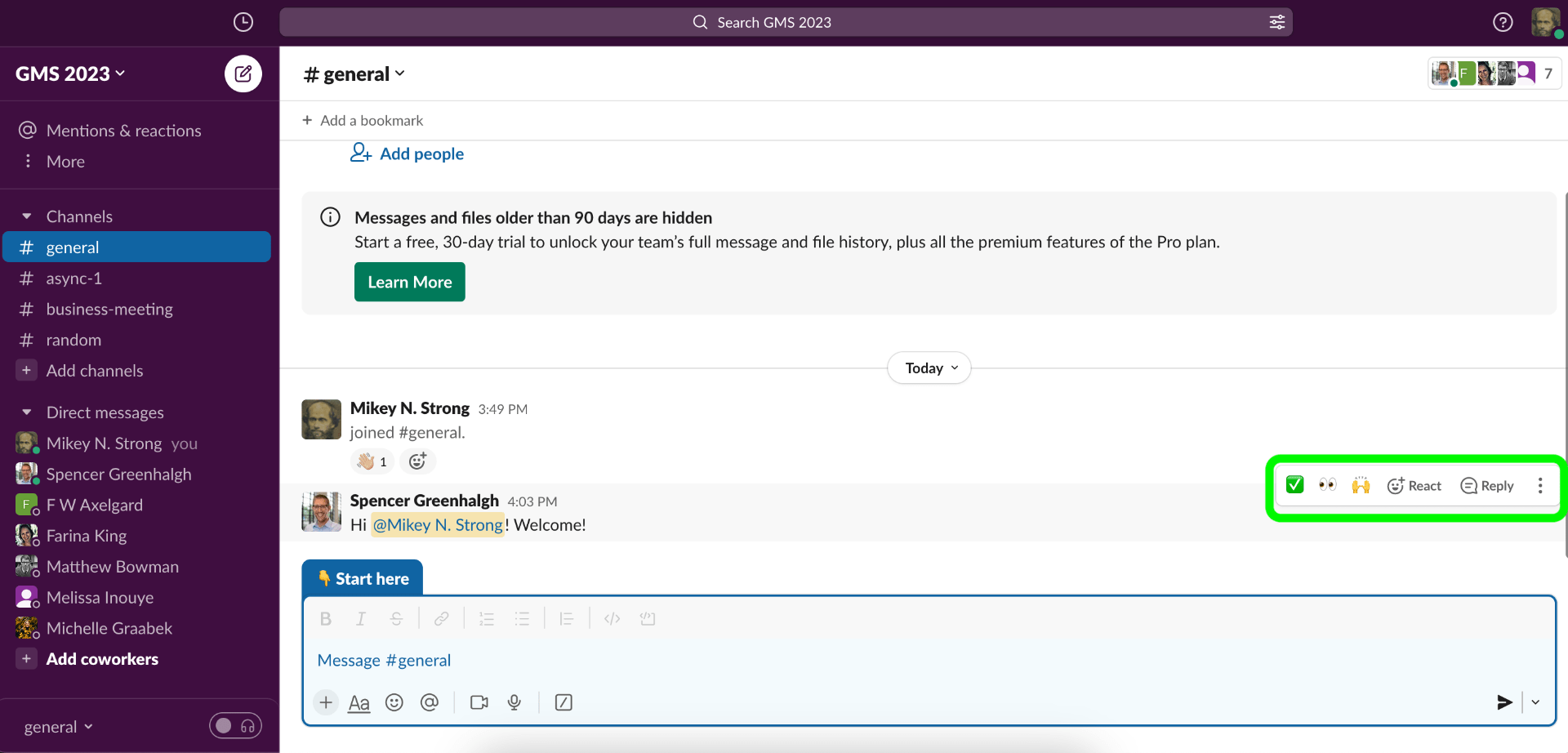
Mikey has a few options for how to respond to this (see the green box). He could type a new message in the box at the bottom of the screen, and that would work just fine. However, it’s usually more helpful to keep conversations self-contained. If Mikey hovers his mouse over Spencer’s message, he sees a few options for responding that will keep that conversation in a single thread. Like Spencer did earlier, Mikey can click on React to use an emoji to respond without typing anything. Or, he can click on the Reply button to say something in return.
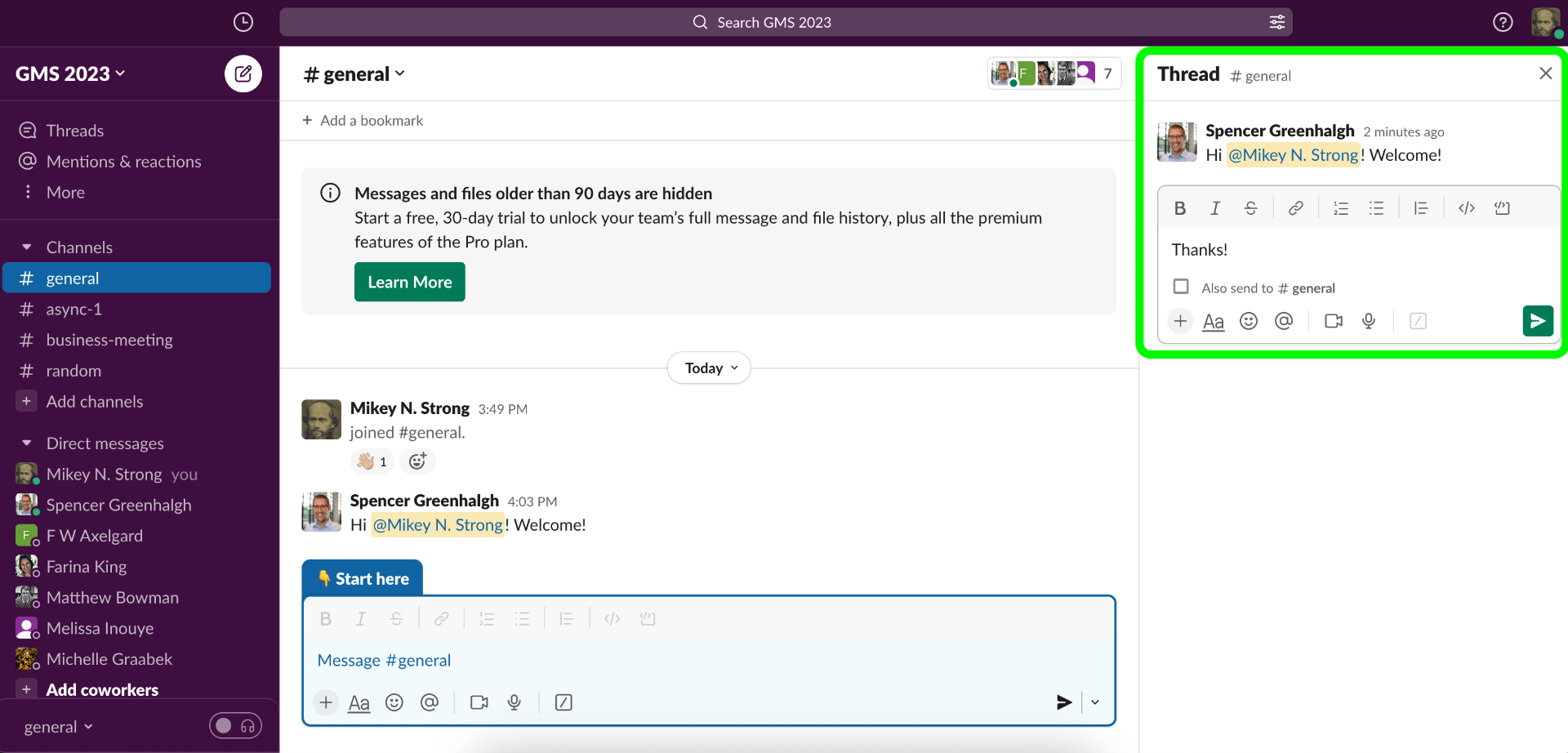
Once Mikey decides to Reply, that will bring up the conversation thread in a sidebar; this helps keep it separate from any other conversations happening in a channel. You can see (in the green box) that there’s an interface for responding to that thread.
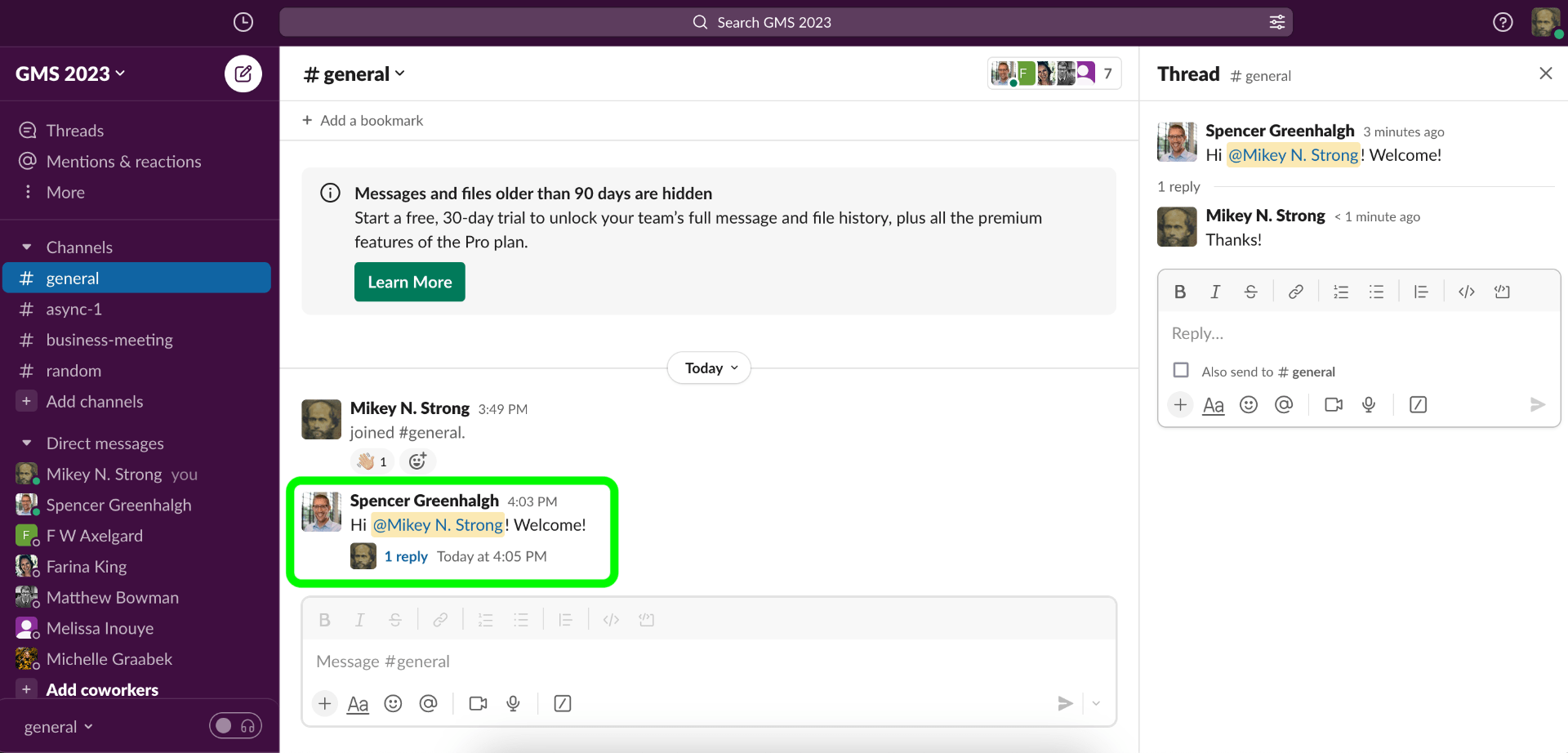
Once Mikey types and submits his reply, that will appear in the sidebar—but there will also be an indication in the main channel that there’s a reply to Spencer’s message. Other people can click on 1 reply to bring up the thread themselves and see if they want to participate. However, people disinterested in Mikey and Spencer’s chat won’t see it cluttering up the main channel screen.
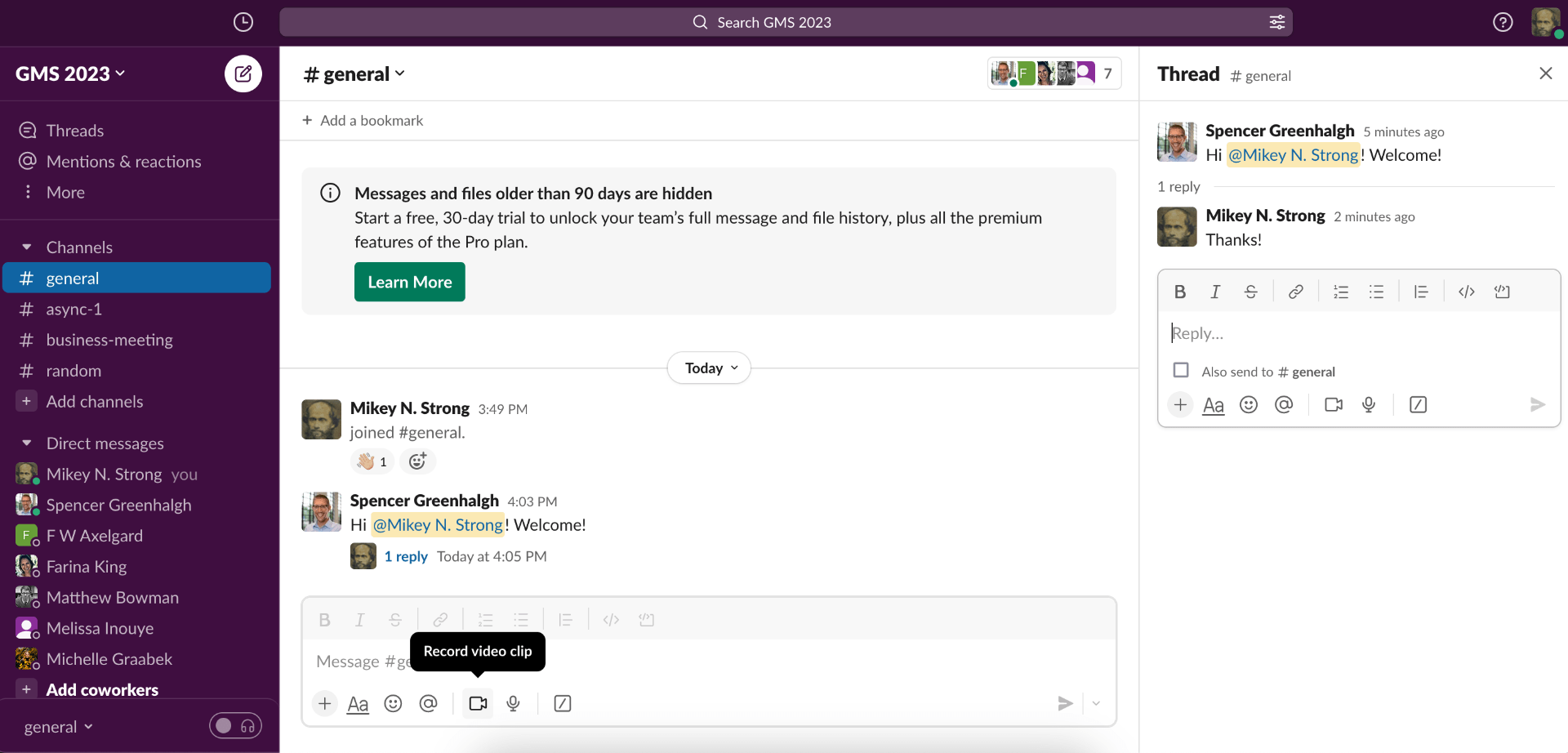
There are lots of other neat things that you can do with Slack messages if you want to try them out! For example, you can see from the screenshot above that you can record video messages (or, slightly to the right, audio messages) if you want to be a bit more personally present in talking with other people. This walkthrough won’t go through all of these features, but we encourage you to try them out—and if you have any questions, you can reach out with questions! We’ll be following the conversations that happen in Slack and can provide troubleshooting there—or another friendly GMS face might have already figured it out and can let you know.